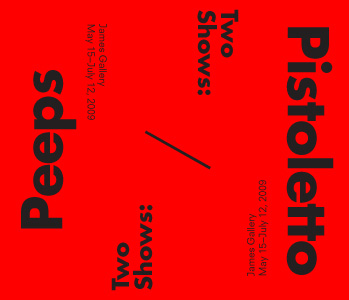
Two Shows:
Peeps / Pistoletto
May 15 - July 12, 2009
Opening Reception
May 15, 6-8PM
The Amie and Tony James Gallery
The Graduate Center of the City University of New York
365 Fifth Avenue
New York, NY 10016
http://www.gc.cuny.edu/events/art_gallery.htm
TWO SHOWS: PEEPS / PISTOLETTO
MAY 15 - July 12, 2009
Exhibition: May 15 - July 12, 2009
Opening Reception: May 15, 2009, 6-8PM
Gallery Hours: Tuesday - Friday 12 – 8 PM; Saturday and Sunday 12 - 6PM FREE
"Two Shows: Peeps/Pistoletto" is part of a larger effort to organize exhibitions around ongoing research here at the Graduate Center. The aim is to devise ways of presenting that work, even before any definite conclusions have been reached. As such, the exhibition itself becomes a part of the inquiry. It's not coincidental that the art historians curating the two shows here use the words experiment and proposal to define their projects.
Amy Herzog's "Peeps" evolved from her work on film theory and the politics of spectatorship, as well as on peep shows, especially those spawned by the proliferation of sex shops and arcades during the sixties and early seventies in many North American metropolitan areas, such as New York's Times Square. The experiment is the exhibition itself, which comprises an unorthodox mix of some vintage porn films and photos featured in those arcades with artworks that use sex or the intimation of sex in similar ways, though often to very different ends. The challenge was to cull a variety of work that might convey not only the porn itself but the varied sexualities to which the arcades catered, the social space that grew up within and as a result of those arcades, and the irony of indulging such intimate and urgent desires in such public and visible surrounds. More than that, the challenge became how to show this. The structure suggested by artist Pierre Huyghe, a series of identical ly scaled cubicles, subject to a set of "rules"—each of the cubicles is pierced by a hole for entry or for looking; walls that have no hole are unfinished on one side—is the exhibition's rationale, an analogue for the sex arcade that mimes the curious combination of publically private space with which Herzog begins her investigation.
Romy Golan's "Pistoletto" is also about looking, but here it's the art that makes us both viewer and voyeur. It too begins with a question. She asks what can be learned from the photographs of Turinese postwar artist Michelangelo Pistoletto's ongoing series of spatially confounding "mirror paintings"—highly polished reflective steel surfaces onto which a drawn figure or object is adhered. The fact that the photos have been mostly neglected in the scholarship on Pistoletto offers a point of entry; the fact that the photos she's interested in are, like the porno booths that Herzog makes her subject, also from the sixties and also addressed to the act of viewing, makes for an interesting pairing. Golan's research, however, is focused primarily on analyzing images and is still in its early stages. The installation at the James Gallery anticipates a full-fledged exhibition of this work planned for 2010, also at the gallery, in conjunction with a major Pistoletto retrospective at the Philadelphia Museum of Art. Everything on display here is a reproduction or mock-up, the aim being to make visible and vivid the photographs in question—the layered and fixed reflections they capture—in contrast to the changing reflections of the mirror paintings.